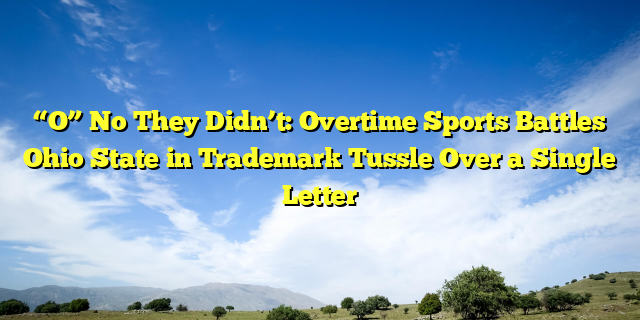The seemingly innocuous letter “O” has become the center of a legal battle between Ohio State University and Overtime Sports, a New York-based sports network. This trademark dispute highlights the complex and often contentious world of intellectual property, where even a single letter can hold significant commercial value. Overtime Sports has taken the fight to federal court, seeking to protect its rounded “O” logo with a rectangular center, which Ohio State claims infringes on their iconic block “O.”
Overtime Sports, specializing in high school sports coverage, asserts that its logo, a capital “O” with sloping corners and a central rectangle, is distinct enough from Ohio State’s block “O.” With a trademark application pending, the company argues that the visual differences are sufficient to avoid consumer confusion.
Ohio State, however, contends that Overtime Sports’ logo is too similar to their trademarked block “O,” a symbol deeply ingrained in the university’s identity since 1898. In a July letter, Samantha Quimby, an attorney representing Ohio State, argued that the block “O” is synonymous with the university in the public’s mind. She asserted that any similar use of the letter, particularly in a sporting context, could lead to brand confusion and dilute the value of Ohio State’s trademark.
Overtime Sports vehemently disagrees. Their federal lawsuit filed in New York City seeks to prevent Ohio State from interfering with their use of the logo. The lawsuit emphasizes the distinct visual characteristics of the two “O”s – the rounded edges and rectangular center of Overtime Sports’ logo versus the solid block design of Ohio State’s. The company also argues that the distinct target audiences—high school sports versus collegiate athletics—further minimize the risk of confusion.
Laura Popp-Rosenberg, Overtime Sports’ attorney, points to the numerous other uses of the letter “O” by various entities, demonstrating that consumers understand not every “O” originates from Ohio State. This, she argues, supports the idea that consumers are sophisticated enough to differentiate between the two logos and their respective brands.
Ohio State, while declining to comment directly on the lawsuit, reiterated its commitment to protecting its brand and trademarks. Spokesman Chris Davey emphasized the significant financial value of the university’s intellectual property, generating $15.5 million in licensing revenue last year and a cumulative $207 million since 1980. This revenue, according to Davey, supports vital university functions like teaching, research, and community service.
This case exemplifies the aggressive brand protection strategies employed by universities, which often extend to trademarking not just logos, but also phrases and even the names of prominent figures like legendary coach Woody Hayes and former coach Urban Meyer in Ohio State’s case. However, these attempts are not always successful. Ohio State’s recent bid to trademark “The” in conjunction with the university’s name was rejected by the U.S. Patent and Trademark Office, which deemed the usage merely decorative rather than a distinguishing trademark.
Further complicating matters is Ohio State’s ongoing dispute with the University of Oklahoma over the latter’s use of the letter “O.” This highlights the challenges of claiming exclusive rights to a single letter, especially one as commonly used as “O,” and underscores the complex legal landscape surrounding trademark law.
The legal battle between Ohio State and Overtime Sports raises important questions about the scope of trademark protection. How far can an institution extend its ownership over a single letter? What constitutes sufficient differentiation to avoid infringement? The outcome of this case could have significant implications for trademark law and branding strategies in the sports industry and beyond, impacting how organizations protect their intellectual property and shaping the future of single-letter trademarks. This case highlights the importance of conducting thorough trademark searches and developing unique branding elements to avoid potential conflicts, especially in a competitive marketplace where intellectual property can be a valuable asset.
